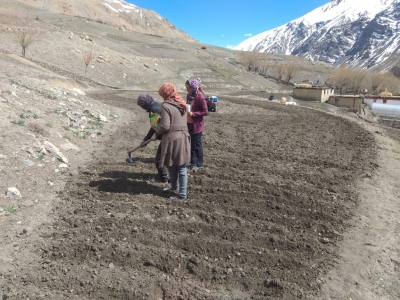Farmers in Himalayan peaks go for long shelf-life peas
By IANS | Published: May 2, 2020 11:47 AM2020-05-02T11:47:54+5:302020-05-02T12:00:12+5:30
He said many farmers in the area are mainly sowing barley, potatoes and wheat, besides black peas owing to market uncertainty over the demand of the green peas in Chandigarh and Delhi at the time of its harvesting in September.Since the traditional black peas have longer shelf life, we are giving them preference than the perishable cash crop green peas," another farmer Tenzin Negi added.State Agriculture Department's Block Technology Manager Sujata Negi, who is based in Kaza, the headquarter town some 320 km from the state capital Shimla, told over phone the farmers are prominently going for the cultivation of the black peas owing to his high shelf life.The total area under the main cash crop green pea in Spiti is 647 hectares, whereas it is 457 hectares barley and 31 hectares under wheat.

Farmers in Himalayan peaks go for long shelf-life peas
Farmers in tiny hamlets spread over Himalayan peaks of the picturesque Spiti Valley of Himachal Pradesh are counting on their peas to see them amid lockdown and market uncertainty.
And, these are no ordinary peas, but the traditional black ones they till last year grew in small quantity just for their own consumption.
This time, fearing the continuation of nationwide lockdown with a possible 'bounce' in the numbers of coronavirus cases time and again, they are giving preference the black peas a pulse to the highly remunerative green ones that otherwise sell like hot potatoes at a premium in the northern plains.
During winter snow, the locals residing at an altitude between 3,000 metre and 4,000 metre that receives negligible rainfall in short summer relish the green peas, potatoes, barley and wheat on soil that is dry and lacks organic matter.
These traditional cash crops are grown in summer and cultivated in August-September. The farming is based on snow-fed 'kul' irrigation system channels to carry water from glacier to the fields.
"This season we have decided not to go for the optimum sowing of the green peas amid fears of lockdown that is getting extended time and again," grower Cheering Dorje of Hikkam village told over phone.
He said many farmers in the area are mainly sowing barley, potatoes and wheat, besides black peas owing to market uncertainty over the demand of the green peas in Chandigarh and Delhi at the time of its harvesting in September.
"If we are not able to market our produce in the neighbouring states, at least we can market them within the state. Since the traditional black peas have longer shelf life, we are giving them preference than the perishable cash crop green peas," another farmer Tenzin Negi added.
The black peas are consumed as a pulse similar to kidney beans and its shelf life lasts up to two years.
The Spiti Valley, the paradise that straddles both India and Tibet, comprising over two dozen small, scattered villages, remains cut off owing to heavy snow accumulation for at least six months in the year.
It reopens once snow starts thawing after mid-April.
State Agriculture Department's Block Technology Manager Sujata Negi, who is based in Kaza, the headquarter town some 320 km from the state capital Shimla, told over phone the farmers are prominently going for the cultivation of the black peas owing to his high shelf life.
She said nearly 1,500 farmer families adopt zero-budget natural farming, a chemical-free method.
They go for multi-cropping by growing radish, spinach and cauliflower too in the total cultivation area of 1,230 hectares.
"These days the local farmers are racing against time in sowing their lone crop in small window of time by adhering to social distancing norms too," she added.
The total area under the main cash crop green pea in Spiti is 647 hectares, whereas it is 457 hectares barley and 31 hectares under wheat.
Cultivation of exotic vegetables in poly-houses are also coming up.
The entire Spiti Valley is populated mainly by tribals. The climatic conditions of the district are harsh as much of the land forms part of a cold desert where the mercury drops below minus 20 degrees Celsius during winter.
The Buddhist-dominated area attracts globe trotters not only for nature-based activities but also to ancient monasteries like Tabo and Dhankar.
( With inputs from IANS )
Open in app